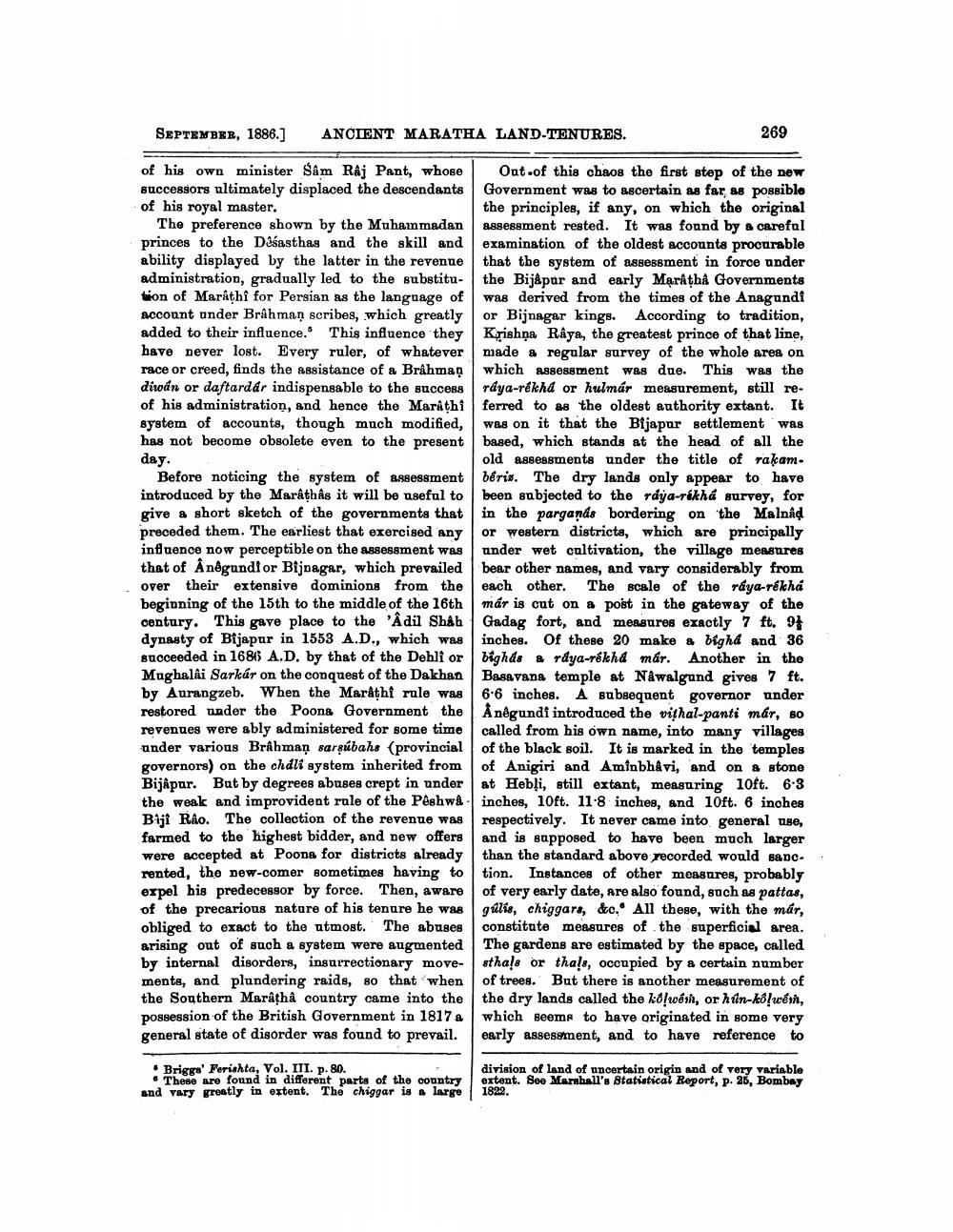________________
SEPTEMBER, 1886.7
ANCIENT MARATHA LAND-TENURES.
269
of his own minister Sam Raj Pant, whose Out of this chaos the first step of the new successors ultimately displaced the descendants Government was to ascertain as far as possible of his royal master.
the principles, if any, on which the original The preference shown by the Muhammadan assessment rested. It was found by & careful princes to the Disasthas and the skill and examination of the oldest accounts procurable ability displayed by the latter in the revenne that the system of assessment in force ander administration, gradually led to the substitu- the Bijapur and early MarathÀ Governments tion of Marathi for Persian as the language of was derived from the times of the Anagandi Account under Brahman scribes, which greatly or Bijnagar kings. According to tradition, added to their influence. This influence they Krishna Raya, the greatest prince of that line, have never lost. Every ruler, of whatever made a regular survey of the whole area on race or creed, finds the assistance of a Brahman which Assessment was due. This was the diwán or daftardar indispensable to the success ráya-rékhd or hulmár measurement, still reof his administration, and hence the Maråthi ferred to as the oldest authority extant. It system of accounts, though much modified, was on it that the Bijapur settlement was has not become obsolete even to the present based, which stands at the head of all the day.
old assessments under the title of raķam. Before noticing the system of assessment beris. The dry lands only appear to have introduced by the Marathas it will be useful to been subjected to the rdya-rákhá survey, for give a short sketch of the governments that in the pargands bordering on the Malnad preceded them. The earliest that exercised any or western districts, which are principally influence now perceptible on the assessment was under wet cultivation, the village measures that of Anègundior Bijnagar, which prevailed bear other names, and vary considerably from over their extensive dominions from the each other. The scale of the raya-rékhá beginning of the 15th to the middle of the 16th már is cut on a post in the gateway of the century. This gave place to the 'Adil Shah Gadag fort, and measures exactly 7 ft. 94 dynasty of Bijapur in 1553 A.D., which was inches. Of these 20 make a bigha and 36 succeeded in 1686 A.D. by that of the Dehli or bighde a rdya-rékhd mar. Another in the Mughalai Sarkár on the conquest of the Dakhan Basavana temple at Nawalgand gives 7 ft. by Aurangzeb. When the Marathi rule was 6-6 inches. A subsequent governor under restored under the Poona Government the Å nêgundi introduced the vithal-panti mar, BO revenues were ably administered for some time called from his own name, into many villages under various BrAhmaņ sarsubahs (provincial of the black soil. It is marked in the temples governors) on the chdli system inherited from of Anigiri and Aminbhavi, and on & stone Bijậpar. But by degrees abuses crept in under at Hebļi, still extant, measuring 10ft. 6:3 the weak and improvident rule of the Peshwa - inches, 10ft. 11.8 inches, and 10ft. 6 inches Biji Rao. The collection of the revenue was respectively. It never came into general use, farmed to the highest bidder, and new offers and is supposed to have been much larger were accepted at Poona for districts already than the standard above recorded would sanc. rented, the new-comer sometimes having to tion. Instances of other measures, probably expel his predecessor by force. Then, aware of very early date, are also found, such as pattas,
the precarious nature of his tenure he was gulís, chiggara, &c. All these, with the már, obliged to exact to the atmost. The abuses constitute measures of the superficial area. arising out of such a system were augmented The gardens are estimated by the space, called by internal disorders, insurrectionary move- sthals or thals, occupied by a certain number ments, and plundering raids, so that when of trees. But there is another measurement of the Southern Maráthâ country came into the the dry lands called the kó!werk, or hiin-ko!wéin, possession of the British Government in 1817 a which seems to have originated in some very general state of disorder was found to prevail. early assessment, and to have reference to
. Briggs' Ferishta, Vol. III. p. 80.
. These are found in different parts of the country and vary greatly in extent. The chiggar is a large
division of land of uncertain origin and of very variable extent. See Morahall's Statistical Report, p. 25, Bombay 1822.




